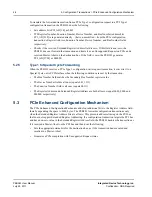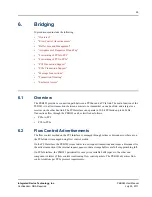
49
PEB383 User Manual
July 25, 2011
Integrated Device Technology, Inc.
Confidential - NDA Required
6. Bridging
Topics discussed include the following:
•
•
•
•
“Assignment of Requestor ID and Tag”
•
•
•
•
•
•
•
6.1
Overview
The PEB383 provides a connection path between a PCI bus and a PCIe link. The main function of the
PEB383 is to allow transactions between a master or a transmitter on one bus\link, and a target or a
receiver on the other bus\link. The PCI Interface can operate in 32-bit PCI mode up to 66 MHz.
Transactions flow through the PEB383 can be classified as follows:
•
PCIe-to-PCI
•
PCI-to-PCIe
6.2
Flow Control Advertisements
The flow control method on the PCI Interface is managed through retries or disconnects, where as on
the PCIe link it is managed using flow control credits.
On the PCI Interface, the PEB383 issues retries to new request transactions and issues a disconnect for
the active transaction if the internal request queues or data storage buffers are full or approaching full.
On PCIe Interface, the PEB383 periodically conveys its available buffer space to the other end
component in terms of flow control credits using flow control packets. The PEB383 advertises flow
control credits as per PCIe protocol requirements.
















































